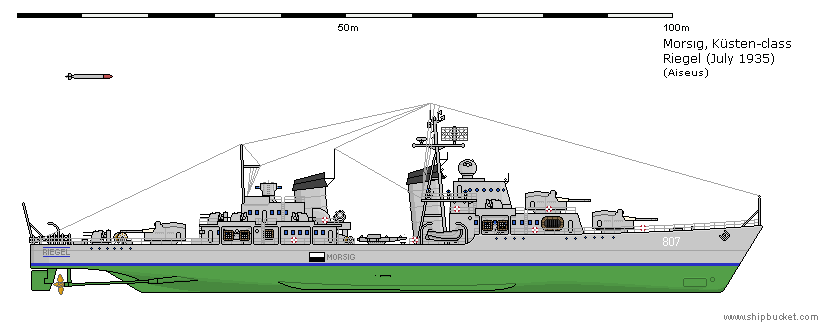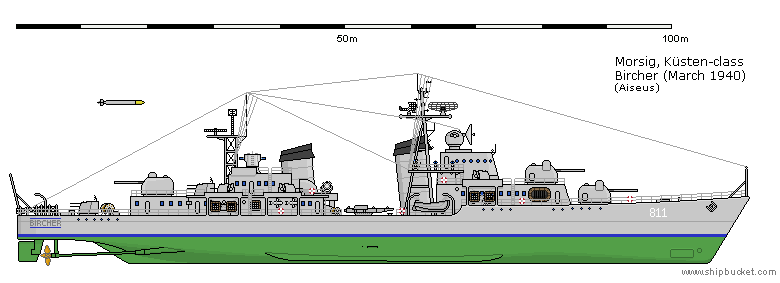Morsig Küsten II-class destroyers
Do note: The dates on the drawings are the years of the designs in my particular AU. I will be placing the equivalent dates to our world in the description, in parenthesis.
The Küsten II-class destroyers were a Morsignian destroyer design dating to (1946), four years before the official end of the Great War. As was standard for Commonwealth destroyers, she was named after a mountain, Mount Küsten. The destroyer class inherited the (II) in its name from the fact that a previous destroyer escort, the Küsten, had been named for the lake at the foot of the mountain which shared its name.
Displacement: 2,900 tons normal, 2,975 full load Length: 111 meters Beam: 11.6 meters Draft: 4.2 meters Maximum speed and SHP: 38 knots on 66,000 HP Range: 1500 km at 15 knots
The Küsten-class, known to Sudovians as the Kaszicze-class, was a late war destroyer of the Morsignian Navy. The end result of several years of doctrinal development, the Küsten was the final class of destroyer built before the demobilization of the Morsignian Navy came into force. With the end of the Great War in sight and the dissolution of the Diotan Commonwealth all but imminent, she was designed to fight their former allies Aufzenians in the local waters of the Sea of Kolden as opposed to fighting in the distant waters off Hymuth as previous destroyers had been. Her armament as built, was designed around three V4 double turrets with the reliable and effective TR125s. An effective dual purpose platform, these guns had been in use for over ten years, and when placed in the newly developed V4 turret, their turn and elevation rate was increased further. Their rate of fire, with the use of an autoloader being implemented on this destroyer class, was able to reach a maximum of 15 rounds a minute on trials. As well as this, the Küstens were the first Morsignian destroyers to use a fully standardized light anti-aircraft caliber, the Aufzenian designed Lirovia 37 mm anti-aircraft guns. The 20 mm Lirovia cannons which had been commonplace for almost the entire war were nearing the end of their effective service life, and were eliminated, and as well as this, it meant that a single light AA fire director could be used. In total, she had 20 37 mm barrels, with two quadruple mounts and 6 double mounts. In line with late-war Morsignian destroyer design, her torpedo armament was weak, with only a single quadruple tube carrying 600 mm torpedoes amidships. Her radar was standard for Commonwealth destroyers of the time, with Aufzenian built surface search radar ObE29 and Morsignian designed air search radar FuE3 on the mast. As well as this, she retained mana-charge detectors, the utility of which had been debated among the Morsignian High Command with the Mage's Union Navy Mage Corps all but eliminated as a serious threat. In her bow was an indigenous sonar array, the UW12, which had been specifically designed to counter Aufzenian submarines using the insider information from three decades working together. Her anti-submarine weaponry consisted of two racks of depth charges located on the rear of the ship. This loadout would remain throughout demobilization until the end of the war.
Riegel, a ship of the Küsten II-class, as she appeared upon the end of the Great War in (1950). Commonwealth destroyer number 807. (The poor relations between Aufzen and Morsig are evident by the hastily painted Morsignian flag on the side of the ship, as Morsignian ships would often refuse to work alongside Aufzenian ships as the war drew down and it became necessary to discern friends from "enemies.")

After the war ended in (1950), the Navy became embroiled in a corruption scandal which would see its funding slashed as a result. With the budget already strained after the demobilization from (1946-1950), the massively expanded Morsignian Navy, intended to counter Aufzenian supremacy in the Sea of Kolden, found itself unable to build new ships to replace the aging ships built during the expansion program undertaken from (1941-1945). As such, it was forced to make do with refurbishing older ships with new weaponry. However, even this proved to be difficult with the funding they had, so modifications were often minor. Such is the case with the Küsten IIs, one of the final classes of destroyer built before the end of hostilities in (1950). Her machinery was untouched, but her armament saw some changes. Her TR125 V4s were replaced with the first indigenously designed Morsignian dual-purpose weapons of the post-war, the BK37, with three guns in three single turrets. Though sharing the same caliber as the TR125s, at 125 mm, these guns were able to manage 35 rounds per minute and had a far faster muzzle velocity than their predecessor. The rear turret had to be placed atop a modified superstructure, though, as there was not enough space for the magazine under where the former turret had sat. Her radar suite saw advancements as well, with her surface and air search radars being replaced with the Morsignian designed GS1 and MFu600 respectively. Her mana-detectors were also removed in this modernization. Her 37 mm quadruple mounts were replaced with fully enclosed mounts with built in directors, while her double mounts were left untouched with the same wartime fire director. Her torpedo tubes, after some debate, were left onboard, though the anti-ship torpedoes which had been mounted were replaced with an anti-submarine variant (notice the gold tip, indicating an anti-submarine role). Her sonar was also left untouched, with Morsignian engineers struggling to improve on the current sonar, the UW12.
Bircher, another Küsten II-class vessel as she appeared in (1955). Morsignian Imperial Navy destroyer (former Commonwealth destroyer) number 811. These vessels were woefully unprepared for the advancement of Aufzenian destroyers, with the top secret compact missile program coming very close to bearing fruit in Aufzen completely unbeknownst to Morsignian engineers. Despite their improvements, they were vastly behind the curve.
